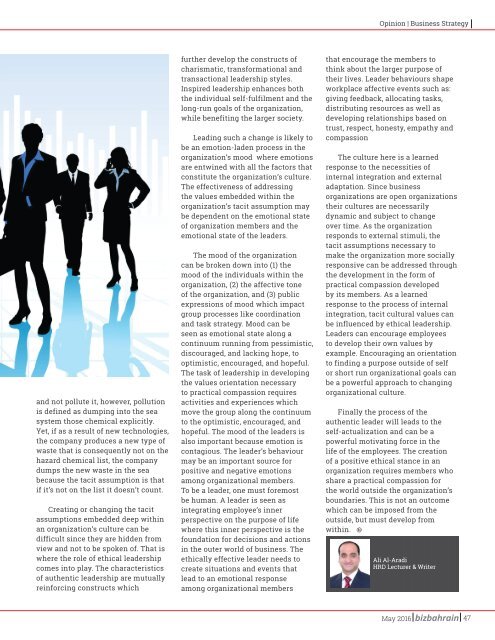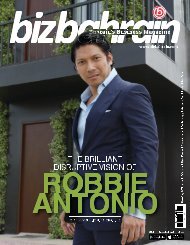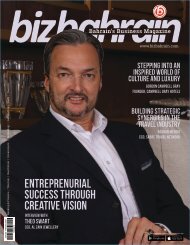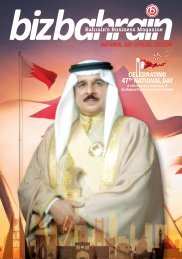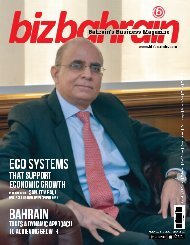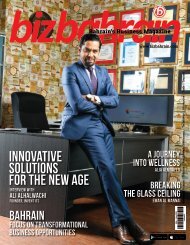BizBahrain April 2016
Create successful ePaper yourself
Turn your PDF publications into a flip-book with our unique Google optimized e-Paper software.
Opinion | Business Strategy<br />
and not pollute it, however, pollution<br />
is defined as dumping into the sea<br />
system those chemical explicitly.<br />
Yet, if as a result of new technologies,<br />
the company produces a new type of<br />
waste that is consequently not on the<br />
hazard chemical list, the company<br />
dumps the new waste in the sea<br />
because the tacit assumption is that<br />
if it’s not on the list it doesn’t count.<br />
Creating or changing the tacit<br />
assumptions embedded deep within<br />
an organization’s culture can be<br />
difficult since they are hidden from<br />
view and not to be spoken of. That is<br />
where the role of ethical leadership<br />
comes into play. The characteristics<br />
of authentic leadership are mutually<br />
reinforcing constructs which<br />
further develop the constructs of<br />
charismatic, transformational and<br />
transactional leadership styles.<br />
Inspired leadership enhances both<br />
the individual self-fulfilment and the<br />
long-run goals of the organization,<br />
while benefiting the larger society.<br />
Leading such a change is likely to<br />
be an emotion-laden process in the<br />
organization’s mood where emotions<br />
are entwined with all the factors that<br />
constitute the organization’s culture.<br />
The effectiveness of addressing<br />
the values embedded within the<br />
organization’s tacit assumption may<br />
be dependent on the emotional state<br />
of organization members and the<br />
emotional state of the leaders.<br />
The mood of the organization<br />
can be broken down into (1) the<br />
mood of the individuals within the<br />
organization, (2) the affective tone<br />
of the organization, and (3) public<br />
expressions of mood which impact<br />
group processes like coordination<br />
and task strategy. Mood can be<br />
seen as emotional state along a<br />
continuum running from pessimistic,<br />
discouraged, and lacking hope, to<br />
optimistic, encouraged, and hopeful.<br />
The task of leadership in developing<br />
the values orientation necessary<br />
to practical compassion requires<br />
activities and experiences which<br />
move the group along the continuum<br />
to the optimistic, encouraged, and<br />
hopeful. The mood of the leaders is<br />
also important because emotion is<br />
contagious. The leader’s behaviour<br />
may be an important source for<br />
positive and negative emotions<br />
among organizational members.<br />
To be a leader, one must foremost<br />
be human. A leader is seen as<br />
integrating employee’s inner<br />
perspective on the purpose of life<br />
where this inner perspective is the<br />
foundation for decisions and actions<br />
in the outer world of business. The<br />
ethically effective leader needs to<br />
create situations and events that<br />
lead to an emotional response<br />
among organizational members<br />
that encourage the members to<br />
think about the larger purpose of<br />
their lives. Leader behaviours shape<br />
workplace affective events such as:<br />
giving feedback, allocating tasks,<br />
distributing resources as well as<br />
developing relationships based on<br />
trust, respect, honesty, empathy and<br />
compassion<br />
The culture here is a learned<br />
response to the necessities of<br />
internal integration and external<br />
adaptation. Since business<br />
organizations are open organizations<br />
their cultures are necessarily<br />
dynamic and subject to change<br />
over time. As the organization<br />
responds to external stimuli, the<br />
tacit assumptions necessary to<br />
make the organization more socially<br />
responsive can be addressed through<br />
the development in the form of<br />
practical compassion developed<br />
by its members. As a learned<br />
response to the process of internal<br />
integration, tacit cultural values can<br />
be influenced by ethical leadership.<br />
Leaders can encourage employees<br />
to develop their own values by<br />
example. Encouraging an orientation<br />
to finding a purpose outside of self<br />
or short run organizational goals can<br />
be a powerful approach to changing<br />
organizational culture.<br />
Finally the process of the<br />
authentic leader will leads to the<br />
self-actualization and can be a<br />
powerful motivating force in the<br />
life of the employees. The creation<br />
of a positive ethical stance in an<br />
organization requires members who<br />
share a practical compassion for<br />
the world outside the organization’s<br />
boundaries. This is not an outcome<br />
which can be imposed from the<br />
outside, but must develop from<br />
within.<br />
Ali Al-Aradi<br />
HRD Lecturer & Writer<br />
May <strong>2016</strong><br />
47


